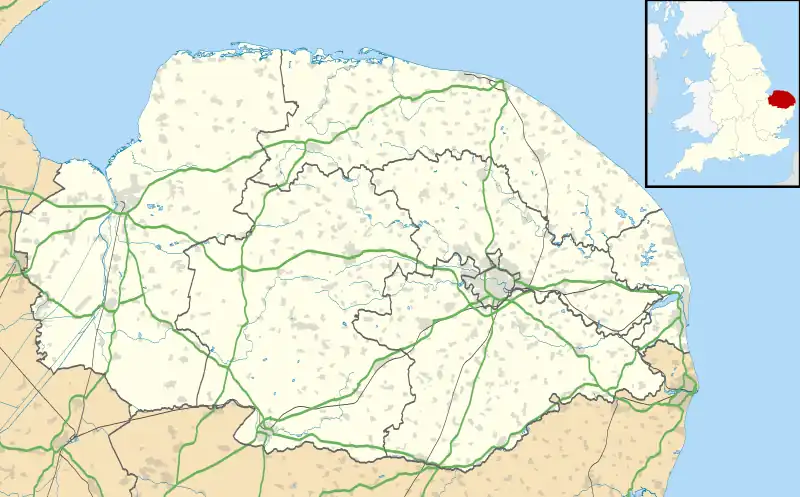| Riddlesworth | |
|---|---|
 St Peter's Church at Riddlesworth Hall School | |
 Riddlesworth Location within Norfolk | |
| Area | 8.26 km2 (3.19 sq mi) |
| Population | 147 |
| • Density | 18/km2 (47/sq mi) |
| OS grid reference | TL966819 |
| Civil parish |
|
| District | |
| Shire county | |
| Region | |
| Country | England |
| Sovereign state | United Kingdom |
| Post town | DISS |
| Postcode district | IP22 |
| Police | Norfolk |
| Fire | Norfolk |
| Ambulance | East of England |
Riddlesworth is a civil parish in the English county of Norfolk. It covers an area of 8.26 km2 (3.19 sq mi) and had a population of 147 in 48 households at the 2001 census.[1] For the purposes of local government, it falls within the district of Breckland.
St Peter's Church
Situated just beyond Riddlesworth Hall and school, St Peter's has an early 14th-century west tower and the plain octagonal font is 15th century.There is a fine monument to Sir Drue Drury (died 1617) of a kneeling knight with angels holding back curtains. The floor slabs at the end of the east end of the nave tell the sad tale of two ladies who were killed in their beds at the hall when a chimney stack fell on them in the 'furious hurricane' of 1703.
Riddlesworth Hall
It is home to the Riddlesworth Hall, a listed Grade II former country house, built in 1792 and subsequently reconverted into a private preparatory school, where Diana, Princess of Wales was a pupil.[2] Set in large grounds, the school was acquired by the Confucius International Education Group in 2015 and catered for children from the age of 7. The school closed in April 2023.
Riddlesworth Polish camp and memorial
During the Second World War, part of Riddlesworth Park was given over to a British Army camp for British troops. In 1946 this camp was redesignated as one of the nearly 150 Polish resettlement camps. These camps were set up under the Polish Resettlement Act 1947 to receive the nearly 250,000 Polish troops and displaced Poles stationed all over Europe at the end of the war.[3] Riddlesworth Camp was one of five set up in Norfolk to receive 4,500 troops and housed the 3rd Heavy Machine Gun Battalion of the 3rd Carpathian Infantry Division. This unit had fought through Italy at all the major battles against German forces and had distinguished itself at the Battle of Monte Cassino in May 1944. The majority of the Polish troops from this camp decided to stay in England after 1948 and were gradually found jobs in the locality and made new lives for themselves.
In 2016, a permanent memorial to the Division was unveiled by the Polish Ambassador to the United Kingdom, Witold Sobków. The memorial was designed and built by local people with the support of the Parish Council. The project was led by Philip Bujak whose father, having served with the Division in Italy, came to Riddlesworth in 1946. Remains of the camp buildings can still be seen amongst the trees.
Gallery
 A visitor to the memorial
A visitor to the memorial The Ambassador for The Republic of Poland Witold Sobkow at the unveiling in April 2016
The Ambassador for The Republic of Poland Witold Sobkow at the unveiling in April 2016 Remains of one of the many Nissen huts at Riddlesworth Camp
Remains of one of the many Nissen huts at Riddlesworth Camp Robert Clegg, Chairman of Riddlesworth Parish Council. and Philip Bujak who led the Memorial project
Robert Clegg, Chairman of Riddlesworth Parish Council. and Philip Bujak who led the Memorial project The memorial unveiled April 2016
The memorial unveiled April 2016 Alfred Zelke the last surviving Polish soldier from Riddlesworth camp
Alfred Zelke the last surviving Polish soldier from Riddlesworth camp Polish troops from 3rd Carpathian Division arrive from Italy at Brandon station in 1947
Polish troops from 3rd Carpathian Division arrive from Italy at Brandon station in 1947
References
- ↑ Census population and household counts for unparished urban areas and all parishes. Office for National Statistics & Norfolk County Council (2001). Retrieved 20 June 2009.
- ↑ British Listed Buildings: Riddlesworth Hall School
- ↑ Polish Resettlement Camps in the UK
External links
 Media related to Riddlesworth at Wikimedia Commons
Media related to Riddlesworth at Wikimedia Commons